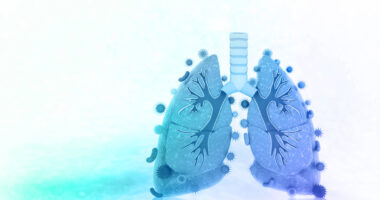Repeat Lung Injury Depletes Stem Cell Pool There, May Promote COPD

Repeated lung injury increases the biological age of lung stem cells and progressively diminishes their regenerative abilities, according to a study in mice and lab-grown human cells.
These findings suggest that such repeat damage contributes to the abnormal repair and tissue remodeling that characterizes chronic obstructive pulmonary disease (COPD) and other chronic lung diseases, the researchers noted.
“This premature aging of the tracheobronchial stem cells (TSCs) in turn may contribute to chronic lung disease,” Susan D. Reynolds, PhD, the study’s senior author and a physician-scientist with the Center for Perinatal Research at Nationwide Children’s Hospital in Columbus, Ohio, said in a press release.
The study, “Repeated injury promotes tracheobronchial tissue stem cell attrition,” was published in the journal STEM CELLS Translational Medicine.
Abnormal repair and remodeling of the lung epithelium — the tissue that lines the airways — is a hallmark of COPD and other chronic lung diseases, such as idiopathic pulmonary fibrosis (IPF), cystic fibrosis, and asthma.
Previous studies suggested that these abnormalities may be associated with lung stem cell aging or exhaustion. Stem cells are characterized by their ability to self-renew, and give rise to several cell types. Aged or depleted stem cell pools are unable to efficiently repair and replace damaged tissue.
In COPD and IPF, the biological age of lung cells was found to be greater than their chronological age. Chronological age is the number of years since birth or the start of existence, while biological age accounts for external factors that affect function.
While these prior works “identified accelerated aging as a novel pulmonary disease process,” Reynolds said, “using this information to develop new therapies to treat patients requires a better understanding of chronological aging and the factors that increase biological age.”
To address this knowledge gap, Reynolds and her team, along with several other colleagues, evaluated the effects of repeated lung injury in the aging and exhaustion of a pool of stem cells in the lungs, called tracheobronchial epithelial tissue-specific stem cells (TSCs).
They began with a mouse model of single and repeated lung injury, in which the animals are exposed to naphthalene, a toxic molecule, commonly used in moth balls, that causes lung epithelial cell death.
They found that naphthalene-induced lung injury activated only a subset of TSCs, which continued to proliferate, or divide, even after the tissue was repaired. Notably, 96% of these activated lung stem cells, when grown in the lab, did not self-renew and instead became fully matured cells, meaning they were lost from the TSC pool.
This indicated that “injury causes selective activation of the TSC pool and that activated TSCs are predisposed to further proliferation,” said Moumita Ghosh, PhD, the study’s first author with the University of Colorado School of Medicine, Anschutz Medical Campus. “It also demonstrated that the activated state of the TSCs leads to terminal [maturation].”
Moreover, a second naphthalene exposure was found to accelerate the proliferation of the previously activated TSCs population, and to activate a new subset of TSCs that contributed to tissue regeneration.
These findings highlighted that “partial activation of the TSC pool conserved the [proliferation] potential of the remaining TSC,” but repeated injury/repair cycles diminish the epithelium’s regenerative potential, and “the magnitude of this decrease is dependent on the number of TSC that are activated by each injury,” the researchers wrote.
Researchers then evaluated whether the same process happened in people, by analyzing lab-grown TSCs from healthy individuals and from people with dyskeratosis congenita, a rare disorder marked by premature aging caused by mutations in genes that provide instructions for making proteins that help maintain telomeres.
Telomeres are specialized structures found at the tip of chromosomes that, much like the plastic tips on the ends of shoelaces, work as protective caps, preventing chromosomes from deteriorating or fusing. However, these structures naturally shorten with each cell division, and shorter telomere lengths are associated with older biological age.
Results showed that, similar to what was observed in mice, repeated proliferation of human TSCs promoted terminal maturation and exhausted the TSC pool.
The TSC pool was also “significantly decreased in DC [dyskeratosis congenita] patients relative to [healthy controls],” Reynolds said, adding that people with DC only had stem cells with short telomeres and shorter lifespans.
These data suggest that healthy TSC pools contain “subpopulations that are characterized by short and long telomeres and that these subsets are comprised of biologically old and young TSC,” reflecting their contribution to epithelial health and repair, the researchers wrote.
“Collectively, the mouse and human studies support a model in which epithelial injury increases the biological age of the responding TSC,” the researchers wrote.
“When applied to chronic lung disease, this model suggests that repeated injury accelerates the biological aging process resulting in abnormal repair and disease initiation,” they concluded.







